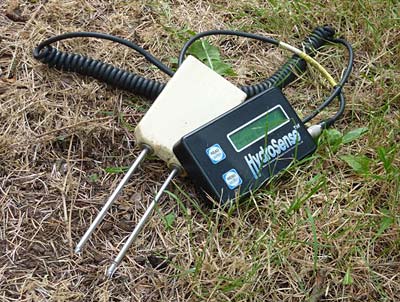
Time domain reflectometry (TDR) is an indirect measure of soil water content based on the travel time of a high frequency electromagnetic pulse through the soil; this travel time is used to calculate the permittivity (dielectric constant) of the material. The TDR probes are inserted directly into the soil for in situ measurement at the desired soil depth. The measurement takes only seconds, and the instrument can be attached to a data logger for ongoing measurements.
The permittivity of the soil is strongly related to the water content due to the unique properties of the water molecule. The dielectric constant of water is about 80, while most of the solid soil components have dielectric constants between 2 and 7, and that of air is equal to 1. Consequently, the dielectric constant of soil is a good parameter to use for calculating the water content of the soil.
The TDR method measures the velocity of propagation of a high-frequency signal. The velocity of propagation in soil (v) can be calculated using the following equation:
v = c / √K’
Where:
c = 3 x 108 m s-1 (propagation velocity of electric signals and light in a vacuum)
K’ = dielectric constant of the soil
TDR applied to soil water content determinations is cable radar in which a very fast rise-time voltage pulse is propagated down and reflected back from the end of a transmission line or wave guide (the probes) in the soil. By determining the travel time (t) of the step pulse traveling in the transmission line or wave guide of length L, the apparent dielectric constant (Ka) can be calculated as:
Ka = (ct/2L)2
c = 3 x 108 m s-1 (propagation velocity of electric signals and light in a vacuum)
It has been shown that the relationship between volumetric water content (θ) and dielectric water constant (Ka) is essentially independent of soil texture, porosity, and salt content. The equation below was developed by Topp et al. (1980) for conversion of Ka to volumetric water content:
θ = -5.3 x 10-2 + 2.92 x 10-2 Ka – 5.5 x 10-4 Ka2 + 4.3 x 10-6Ka3
There is a variety of TDR probes available, which allows the measurement of soil water content to be “tailored” to the experimental objectives. The choice of soil probe type and orientation of probe installment into the soil depend on the intended use of the resulting data.
Click here to download a video notes sheet before watching the following video.
References and Resources:
Topp, G.C., J.L. Davis, and A.P. Annan. 1980. Electromagnetic determination of soil water content: measurement in coaxial transmission lines. Water Resources Research 16: 574-582.
Things to Consider
When determining soil water content, some things to keep in mind are:
- Sampling scheme
- Type of method used